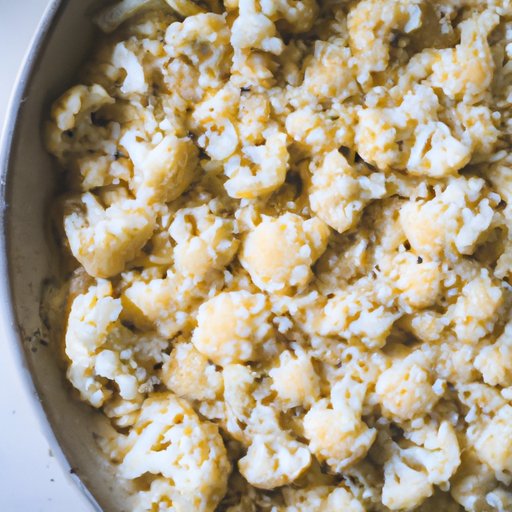
I. Introduction
Have you ever wondered how to rice cauliflower? Are you tired of eating plain, boring rice and looking for a healthier and more versatile alternative? Look no further! Riced cauliflower is an excellent option for anyone looking to add more vegetables to their diet and try new recipes.
II. Step-by-Step Guide: How to Rice Cauliflower like a Pro
Ricing cauliflower can be a bit tricky if you don’t know the right technique. It requires a bit of preparation and patience, but the results are worth it. To achieve the desired texture, it is crucial to follow a specific procedure. Here is a step-by-step guide to rice cauliflower like a pro:
- Cut the cauliflower head into florets and discard the stems. Rinse thoroughly with water and dry with a paper towel.
- Grate the cauliflower florets using a food processor or a hand grater. Be careful not to overprocess the florets, or they will turn into mush.
- Transfer the grated cauliflower to a microwave-safe bowl and cover it with a lid or plastic wrap.
- Microwave the cauliflower on high for 3-4 minutes, depending on the quantity. This will steam the cauliflower and soften it slightly.
- Remove the bowl from the microwave and let it cool for a few minutes before fluffing the riced cauliflower with a fork.
- Your riced cauliflower is ready to use! Store it in an airtight container in the refrigerator for up to four days.
If you don’t have a food processor or a grater, you can use a knife to finely chop the cauliflower florets. It will take more time, but the result will be similar.
III. 5 Delicious Recipes to Try with Riced Cauliflower
Riced cauliflower is an incredibly versatile ingredient that can be used in a variety of recipes. Here are five delicious ideas to get you started:
- Fried “Rice”: Replace regular rice with riced cauliflower in your favorite fried rice recipe.
- Cauliflower Pizza Crust: Swap regular pizza crust for a cauliflower crust for a healthier and gluten-free alternative.
- Cauliflower “Mashed Potatoes”: Mix riced cauliflower with mashed potatoes to add extra nutrition and reduce the carb count.
- Cauliflower Tabbouleh: Use riced cauliflower instead of bulgur wheat in a classic tabbouleh salad recipe.
- Cauliflower Rice Salad: Mix riced cauliflower with fresh herbs, lemon juice, olive oil, and your favorite veggies for a refreshing and light salad.
IV. Make Your Own Riced Cauliflower in Under 5 Minutes
If you are short on time or don’t want to bother with a food processor, you can make your own riced cauliflower in under five minutes using a pre-made mix. Many grocery stores sell fresh or frozen riced cauliflower that you can use as a shortcut. Here is how:
- Buy a pack of fresh or frozen riced cauliflower from your grocery store.
- Transfer the cauliflower to a microwave-safe bowl.
- Microwave the riced cauliflower on high for 2-3 minutes until it is tender.
- Fluff the cauliflower rice with a fork and add seasoning if desired.
- Your riced cauliflower is ready to use as a base for a variety of recipes!
This method is a quick and easy alternative if you are short on time or don’t want to fuss with a food processor. Just make sure to check the ingredient list and choose a mix without any added sugars or preservatives.
V. The Health Benefits of Riced Cauliflower and Why You Should Try It
Cauliflower is one of the healthiest vegetables you can eat. It is low in calories and high in fiber, vitamins, and minerals. Riced cauliflower is an excellent way to add more vegetables to your diet and reap all the health benefits. Here is a list of some of the perks of riced cauliflower:
- Low in calories and carbs: Riced cauliflower is a great alternative for anyone watching their calorie intake or following a low-carb diet.
- High in fiber: The high fiber content of cauliflower can help regulate digestion and promote gut health.
- Rich in vitamins: Cauliflower is a great source of vitamins C and K, as well as folate and potassium.
- Anti-inflammatory: Cauliflower contains antioxidants that can help reduce inflammation and protect against chronic diseases.
- May help with weight loss: The high fiber and low-calorie content of riced cauliflower can help you feel full and satisfied with fewer calories.
VI. Riced Cauliflower vs. Regular Rice: Which One is Better for You?
While both riced cauliflower and regular rice can be part of a healthy diet, they have different nutritional profiles. Here is a comparison:
- Calories: One cup of cooked white rice contains around 200 calories, while one cup of riced cauliflower has only 25-30 calories.
- Carbs: One cup of white rice contains around 45-50 grams of carbs, while one cup of riced cauliflower has around 4 grams of carbs.
- Fiber: White rice is low in fiber, while riced cauliflower is high in fiber.
- Nutrients: Cauliflower is a great source of vitamins and minerals, while white rice is mostly empty calories.
While regular rice can be a good source of energy for active individuals, riced cauliflower is a better option for anyone looking to reduce their calorie and carb intake or increase their vegetable intake.
VII. Conclusion
Riced cauliflower is a delicious and healthy alternative to regular rice that you can use in a variety of recipes. It is easy to make, versatile, and packed with nutrients. Give it a try and see how it can transform your cooking!
Are you ready to rice some cauliflower? Head to your grocery store and grab a head of cauliflower or a pre-made mix, and start experimenting with new recipes.





